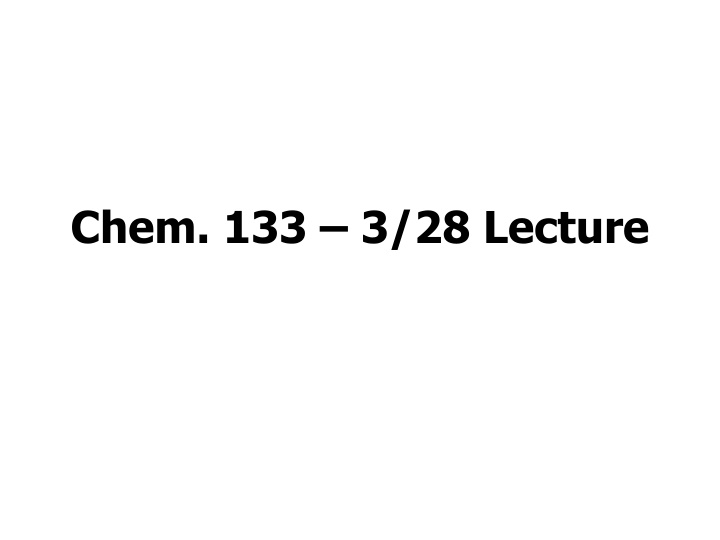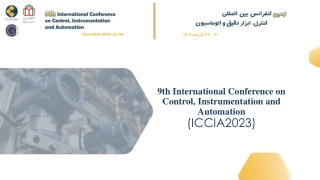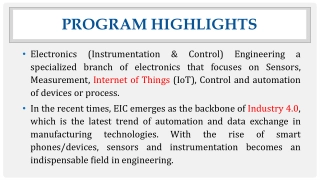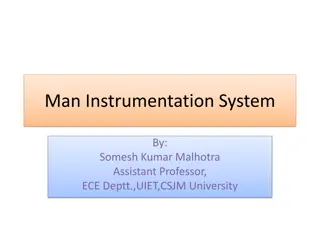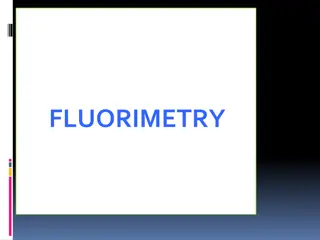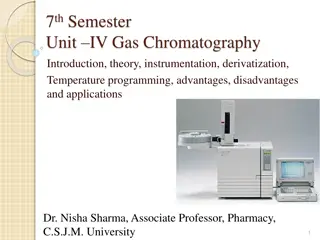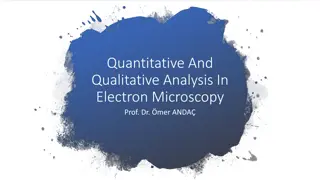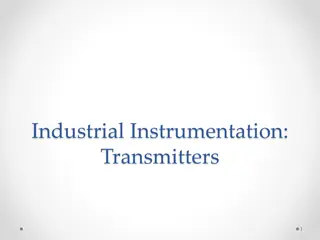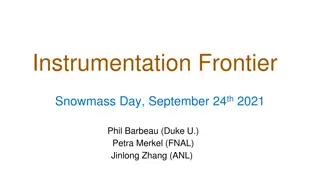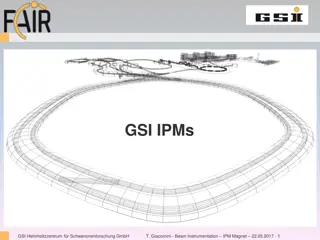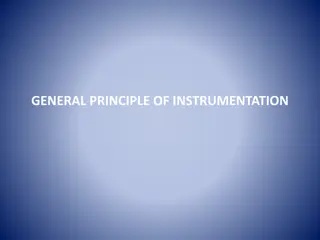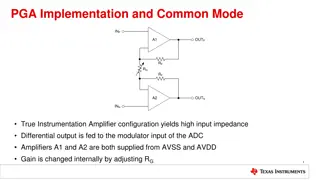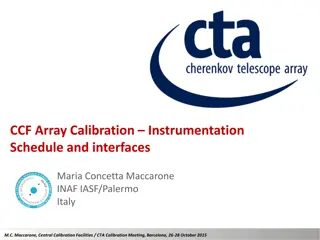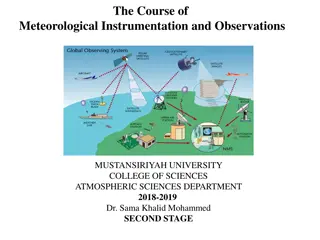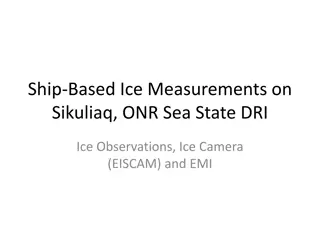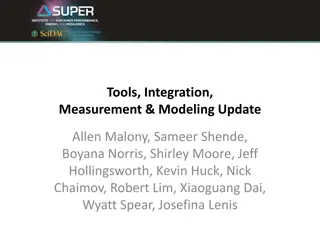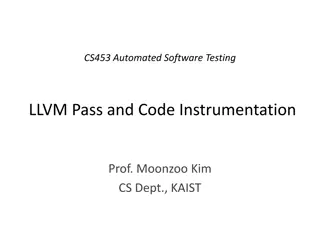Introduction to Spectroscopic Instrumentation and Monochromators
Today's lecture covers spectroscopic instrumentation with a focus on monochromators. It delves into the components and performance measures of spectrometers, including wavelength discrimination filters, light detectors, and energy dispersive detectors. The dispersion of light through prisms and gratings, as well as strategies to enhance resolution and linear dispersion, are also discussed. Students will gain insights into the operation and optimization of monochromators for precise wavelength selection in spectroscopy.
Download Presentation

Please find below an Image/Link to download the presentation.
The content on the website is provided AS IS for your information and personal use only. It may not be sold, licensed, or shared on other websites without obtaining consent from the author.If you encounter any issues during the download, it is possible that the publisher has removed the file from their server.
You are allowed to download the files provided on this website for personal or commercial use, subject to the condition that they are used lawfully. All files are the property of their respective owners.
The content on the website is provided AS IS for your information and personal use only. It may not be sold, licensed, or shared on other websites without obtaining consent from the author.
E N D
Presentation Transcript
Announcements Second Homework Set Additional Problems due Thursday Next Quiz on Thursday Today s Lecture Spectroscopic Instrumentation (Chapter 19) Wavelength Discrimination Filters (covered last time) Monochromators Polychromators Other methods Light Detectors Transducers Energy dispersive detectors
Spectrometers Monochromators collimating optics entrance slit A. Components 1. Entrance Slit (to match exit slit) 2. Light Collimator (optics to make light beam parallel when falling on dispersive element) 3. Dispersing Element (to disperse light at different angles for different values) 4. Focusing Optics (to focus light on exit slit) 5. Exit Slit (to select range of values passed ) light grating 1 2 Focusing optics exit slit In this example, wavelength selection occurs through rotation of the grating
Spectrometers Monochromators 2 B. Dispersion of Light 1. Prisms based on refractive index (n) = f( ) 2. Gratings based on constructive interference a. 2 beams hitting grating will travel different distances b. travel difference = a b c. this difference must be an integral # of to lead to constructive interference d. a b = n (n = integer) e. from geometry, n = d(sin sin ) f. Each groove acts as a light source 1 d extra distance traveled by beam 2 = a extra distance traveled by beam 1 = b d = groove spacing = incoming light angle = outgoing light angle
Spectrometers Monochromators B. Performance of Grating 1. Resolution = / = nN where n = order (1, 2, 3...) and N = No. grooves illuminated 2. To increase resolution, a. decrease d (groove spacing) b. increase length of grating illuminated (perpendicular to grooves) c. use higher diffraction order (n = 5 vs. n = 1) 3. Dispersion from gratings: a. Angular dispersion = / = n/dcos b. Linear dispersion = D = y/ = F / F = focal length Exit slit y-axis
Spectrometers Monochromators B. More on Linear Dispersion 1. y = slit width = W: related to band width passed through monochromator ( ) 2. = Wdcos /Fn 3. For better resolutions, a) Decrease W b) Use smaller d c) Use larger d) Use larger F e) Use larger n 4. All have drawbacks: a), c) and e) decrease light throughput b) Gratings more readily damaged d) Means larger monochromator e) Has more interferences from other n values
Wavelength Discrimination Monochromators Other Performance Measures (besides resolution) light throughput (% of light entering monochromator which exits monochromator) scanning range ( min to max) stray light (light passed through monochromator outside of selected )
Spectrometers Some Questions I 1. List one type of discrete light source. 2. List one method to create monochromatic light from a white light source without a monochromator. 3. List the five major components of a monchromator.
Spectrometers Some Questions II 1. If white light enters the monochromator to the right, which wavelength is longer wavelength? List two parameters that will affect the resolution. Can any of these be easily changed? A band pass filter is often placed between the grating and the focusing optics. What is the purpose of this filter? If a grating is used with 320 lines/mm and the output angle for 380 nm is 45 and the focal length is 40 cm for 1st order light, what exit slit width is needed to be able to obtain a resolution of 200? 2. 3. 4. 1 2 exit slit
Spectrometers Wavelength Discrimination sample C. Polychromators 1. In place of exit slit, an array of detectors exists 2. This allows simultaneous recording of absorption over wavelength range 3. No rotation of grating is needed 4. Resolution (mainly) determined by width of detector element y = k light 1 2 Detector element Detector array top view y
Spectrometers Wavelength Discrimination C. 2-D Polychromators 1. Light can be dispersed in two dimensions by placing a prism in front of the grating (dispersion in and out of the screen) to go along with the grating s dispersion (in y-axis) 2. See Color Plate 25 in Harris 3. Requires 2-D detector array 4. Usually uses high order grating dispersion (e.g. n = 11, 12, 13, 14) with different orders separated by prism emission light source prism 1 2-D detector array 2 prism dispersion Detector elements grating dispersion (y-axis)
Spectrometers Wavelength Discrimination D. Other Methods 1. Energy-dispersive detectors (X-ray and -ray analysis) wavelength discrimination is part of detection system 2. Fourier-transform Instruments - Will cover for IR (today) and NMR - White light passed through sample - Variance in response with time or with distance is recorded and then transformed to conventional spectrum
Wavelength Discrimination Fourier Transform Instruments FTIR Instruments Uses Michelson interferometer (see Figure) Light goes to beam splitter (partially reflecting/partially transmitting Part of beam goes to fixed mirror and is reflected. Part of this beam then goes through the sample to the detector Another part of the original beam goes through the beam splitter to a moving mirror and is reflected with part of this going on to the sample and detector Fixed mirror Beam splitter light Mirror on drive sample detector
Wavelength Discrimination Fourier Transform Instruments FTIR Instruments (continued) If beams from the two paths combine in phase (both wave maxima) constructive interference occurs and greater light intensity reaches sample/detector If beams are not in phase , less light reaches detector Distance between beam splitter and mirror affects whether light is in phase Since white light is used (actually broad band IR), at different distances, different wavelengths will be in phase Recorded signal is Fourier transformed so plot of intensity vs. mirror distance or time is converted to intensity vs. frequency intensity 1 2 Mirror position (or time if mirror moves)
Wavelength Discrimination Fourier Transform Instruments Performance: (range of wavenumbers passed) is inversely related to distance traveled by mirror ( ) (not explained clearly in text) This means better resolution (larger / ) when is larger Spectral range depends on sampled data speed (assuming fast detector) High resolution over a long wavenumber range will take more time small displacement poor resolution
Spectrometers Light Detectors Detectors covered in electronics section UV/Vis/NearIR: Photocell, photomultiplier tube, photodiode, photoconductivity cell, and solid state array detectors (charged coupled device or CCD) IR: temperature measurement (e.g. thermopile), and solid state NMR: antenna
Spectrometers Light Detectors Detectors for high energy (X-ray, -ray light) (both gas cells and solid state available) Due to high energy, a single photon can easily produce a big signal Two types: gas cells (e.g. Geiger Counter) and solid state sensors (e.g. Si(Li) detectors) In both cases, detectors can be set up where cascade of electrons is produced from a single photon The number of ions produced from photons can be dependent upon the photon energy I These detectors are said to be energy dispersive (no monochromator needed) + solid state detector + - + - - counts/s current high E photon low E photon energy time
